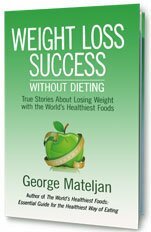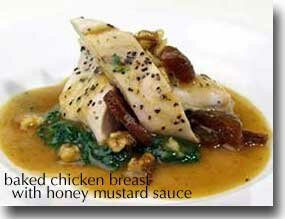Check Out What's New On Our Website
 Find out how to keep your New Year's resolution and lose those extra pounds with our Weight Loss Success-Without Dieting book.
Take advantage of our special offer and save $7.00. You pay only $17.00!
Find out how to keep your New Year's resolution and lose those extra pounds with our Weight Loss Success-Without Dieting book.
Take advantage of our special offer and save $7.00. You pay only $17.00!
healthy food tip and recipe
Today's Recipe
If you don't know what to serve for dinner tonight ...
Enhance the flavor of chicken with this special honey-mustard sauce and serve with spinach for a great tasting addition to your Healthiest Way of Eating. Enjoy!

Ingredients:
- 4 boneless chicken breasts with skin
- 2+1 TBS fresh lemon juice
- 1 1/2 cups chicken broth
- 2 1/2 TBS honey
- 2 TBS Dijon mustard
- 1/4 cup sliced dried apricots
- 2 TBS coarsely chopped walnuts
- 1 TBS chopped parsley
- salt and pepper to taste
Quick Broiled Chicken
- Preheat the broiler on high and place an all stainless steel skillet (be sure the handle is also stainless steel) or cast iron pan about 6 inches from the heat for about 10 minutes to get it very hot.
- While the pan is heating, rinse and pat the chicken dry and season with 2 TBS lemon juice, salt, and pepper.
- Leaving the skin on, place the breast skin side up on the hot pan. It is not necessary to turn the breast because it is cooking on both sides at once. Depending on the size, it should be cooked in about 7 minutes. Begin preparing the sauce while the chicken is cooking.
- The breast is done when it is moist, yet its liquid runs clear when pierced. The inside temperature needs to reach 165°F (74°C). Remove the skin before serving; it is left on to keep it moist while broiling.
Honey-Mustard Sauce
- For honey-mustard sauce, combine broth, 1TBS lemon juice, honey, and mustard in a small saucepan. Whisk together and bring to a boil on high heat. Once it comes to a boil, simmer for about 20 minutes. You want it to be reduced to a little less than half the volume you start with. This will thicken and intensify the flavor.
- Add apricots and cook on high for another 5 minutes. When sauce is done, add chopped walnuts, parsley, salt ,and pepper. Serve over cooked spinach or other cooked greens.
In-Depth Nutritional Profile for Quick Broiled Chicken Breast with Honey-Mustard Sauce
Healthy Food Tip
On a television news program today, I heard someone say that whole-wheat bread is not a whole-grain food because it's made of flour. Is that true?
No, what you heard is not true. The fact that bread has been made from flour does not automatically mean that it's not whole grain.
There are many different ways of making flour from grain. Most of these ways can be classified according to a measurement system called "percent extraction." When a grain is harvested, it's essentially whole in nature. The flour must then be extracted from the grain.
When flour is classified as 100% extraction, 100% of the whole grain that went into the extraction equipment is recovered in the flour itself. This type of extraction flour is therefore completely whole grain and is considered 100% whole grain wheat.
Unfortunately, the vast majority of breads in the supermarket aren't anything close to 100% extraction. Most of them are much closer to 60% extraction, which means that only 60% of the whole grain ends up in the flour. The other 40% of the whole grain (mostly the germ and bran portion) never makes it into the final flour at all.
Unfortunately, no breads on the grocery store shelf will tell you their percent extraction. The labeling of bread in the United States has long been a source of confusion for consumers, and even though the U.S. Food and Drug Administration (FDA) issued some new voluntary policy guidelines for the labeling of whole grain products in February 2006, the non-binding nature of these guidelines is unlikely to make bread labeling much clearer.
With respect to wheat, many types of bread simply carry the label "wheat bread" in very large letters. That label tells you absolutely nothing about the whole grain content of the bread. (Most of the time, however, there is very little or no whole grain content in breads that are simply labeled, "wheat bread.") The label "whole wheat bread" may help a little bit, but please note that companies are allowed to use the label "whole wheat bread" even when a very, very small amount of 100% extraction wheat flour has been used to make the bread. In strictly legal terms, a "whole wheat bread" could contain very, very little whole wheat.
The label "100% whole wheat bread" is another story. In this case, all of the wheat flour in the bread would be 100% extraction. Therefore, "100% whole wheat bread" would indeed be the most nutritious wheat bread available-provided, of course, that it was also made from organically grown wheat.
In its 2006 guidance statement on the labeling of grain products, the FDA recommended that the principle components of a grain (including the bran, germ, and starchy main portion, called the endosperm) be present in a whole grain flour "in the same relative proportions as they exist in the intact grain" in order for the flour to be considered "whole grain." While this recommendation did help to clarify the intended use of the term "whole grain," it also left some room for manufacturers to use something less than 100% extraction wheat flour in a bread and still refer to that bread as whole grain. More important was the fact that this guidance statement carried with it no mandatory action. Companies were not required to limit their labeling claims, just asked to voluntarily adopt a general labeling approach.
Your best bet is to look for wheat breads that advertise themselves as being "100% whole wheat" and that also carry the USDA's symbol of being certified organic. That same principle would apply to all other whole grain breads as well (not just those made from wheat).
For more information on the FDA's definition of whole grains, please see their website at http://www.cfsan.fda.gov/~dms/flgragui.html.
For more information on this topic, please see:
References:
U.S. Food and Drug Administration. (2006). Guidance for Industry and FDA Staff: Whole Grain Label Statements. Draft Guidance. Food Labeling and Standards Staff Office of Nutritional Products, Labeling and Dietary Supplements, Center for Food Safety and Applied Nutrition, College Park, Maryland.

No comments:
Post a Comment